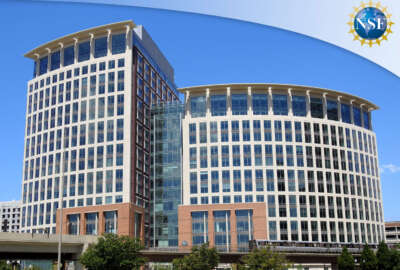Commerce sends hope, maybe some skill, out to the nation’s poor areas
A non-profit grantee in a cooperative agreement with the Commerce Department, plans to seed the country with specialized nerds.
A non-profit grantee in a cooperative agreement with the Commerce Department, plans to seed the country with specialized nerds. The International Economic Development Council has recruited 65 of what it calls economic recovery corps fellows. They will fan out to distressed areas and help get local economies going. For details The Federal Drive with Tom Temin spoke with Nicole Manapol, Senior Director of the Council’s Economic Recovery Corps.
Interview Transcript:
Tom Temin I just called your fellows nerds, which is probably not a great way to put it, but these are people that have a very serious interest in economic development in poor areas. Is that a good way to put it?
Nicole Manapol Yeah. Our fellows are all deeply committed to community development, economic development and social impact, and have long histories of working in areas that have been stricken with poverty and underinvested.
Tom Temin And review for us, briefly, the goal of the Economic Development Administration, which has you running this program. That’s just the fellows are recently recruited, we’ll get to that. But what are they trying to accomplish here?
Nicole Manapol Yeah. So really the purpose of the Economic Recovery Corps program is twofold. Number one, it’s about designing. It was designed to really accelerate recovery from the pandemic. So as you know, and you might have heard from Craig who was on your show a year ago, the funding for this comes from the CARES act. So it was a COVID era response to the distress and challenges that we’re seeing in the community. And so in this first instance, it’s really about building capacity in some of the hardest hit and most economically distressed areas across the United States. And number two, it’s about also looking at the future and cultivating that next generation of economic development leaders.
Tom Temin All right. And just want to point out, though, that if you drive around the country, rural Pennsylvania, places the Appalachian area and places out west, in the Midwest, there has been kind of economic devastation for some time now caused by the hollowing out of the industry in the United States outsourcing of jobs overseas, etc., etc., well-documented. These are areas that are part of this program also?
Nicole Manapol Absolutely. So over the last year of launching the program, we had over 500 applications from communities, organizations across the country. We had to narrow that down to 65. And the outcome of that has been we’re going to be working in 62% of that 65 are in rural communities, just as you described. 23% of those will be kind of in a mixed setting. So urban, rural, suburban and 15% are based in urban areas.
Tom Temin And who are these people? What kinds of skills and backgrounds generally did you look for in retaining them?
Nicole Manapol So we were really looking at a different type of professional, I would say. So as Craig mentioned on your show a year ago, much of our recruitment efforts were driven by the host communities and the places we were trying to serve. And so I think what’s interesting about our fellow cohort is that we were very intentional about trying to find individuals with lived experience of many of these places that they would be working or had some background, professional experience working, whether it was in rural or tribal or urban areas. And so that was a really important component of it. And I’m excited to say that 69% of the fellow cohort are women, 54% identify as a person of color, again, really representing the places we’ll be serving through this program. And 65% had ten plus years of professional experience. And this was really important to us, because we wanted to be able to provide immediate assistance, immediate value to these communities with seasoned professionals who have worked in these challenging contexts before and could really hit the ground running.
Tom Temin We’re speaking with Nicole Manapol. She is senior director of the Economic Recovery Corps at the International Economic Development Council. And when they arrive somewhere, where do they attach themselves? Some towns might have a Lions Club or a business council or a local government. Some places you go, you see like an Indian reservation and there ain’t much there at all. And so how do they get situated and what do they do when they arrive?
Nicole Manapol So, again, all of this has been driven by selecting host organizations. So partner organizations that are based in these communities. And, again, there is diverse as our fellows. There are a range of CDFIs. We have economic development organizations, we have economic development districts, we have counties, we have municipalities, small community kind of main street associations. So really the diverse mix that makes our economic landscape. So these are the places that our fellows have been contracted to work through in the next two and a half years.
Tom Temin Now these places, as you say, had a structure and organizations in place, and yet nothing is happening to the satisfaction of the local people and to the aims of the Commerce Department. So what do they bring? What can change? Because to have jobs, you need demand by somebody building a factory, opening a plant, a distribution warehouse, whatever the case might be, or starting a whole new industry. What do they do to spark actual economic development? I’m trying to understand the process. Now there’s a job where there wasn’t one two weeks ago.
Nicole Manapol Yeah. So I’m not sure that I would characterize it exactly like that. So we’ve been working, we work to identify places that, yes, have been experiencing economic distress, have been under invested in or as we like to say underestimated and underinvested in. And so it’s not to say that there’s nothing going on there. A lot of the most organizations in the projects that we selected as part of this actually are doing really innovative work in economic development. It’s just not visible. And so I think the opportunity, both with the sellers going there and providing capacity, human resources to help advance a plan, a project, an initiative that these communities have been dreaming about for years, but just haven’t had the talent or the human resource capacity to carry those things across the line. That’s really the opportunity for this. But I wouldn’t characterize it so much that there’s nothing happening there. There’s lots of innovation that I see happening across this country and through this program.
Tom Temin Give us an example of something where there might be the seed of real growth in an area and how it can become flowered so that there is measurable growth.
Nicole Manapol Absolutely. So especially in a lot of the the rural and tribal areas that we’re working in, you’re seeing focus on trying to build rural livelihoods that connect to their regional assets. So a lot of work is going into kind of the outdoor recreation economy. One of the places that we’re going to be working is the wind River Reservation. Our lead partner there is the Wind River Development Fund. It’s a native led CDFI, community development finance institution. And they’re really looking at, again, how are they developing business opportunities for their tribal members around? If your listeners aren’t familiar with Wind River, it’s as large as Yosemite and completely pristine, some of the best fly fishing in the country. And so they’re really looking at building up their outdoor recreation assets, tourism, things like that, that, again, leverage their strengths and build opportunities for their tribal members as entrepreneurs.
Tom Temin And what about areas that are semi-rural or small towns, for example, where you can physically see the dead factories, the brick buildings with a windows or missing and this kind of thing where clearly there was activity. It could have been a century ago, it could have been 75 years ago. Slowly they’ve been hollowed out. And yet, housing is there and there’s a downtown and so forth. What about areas like that?
Nicole Manapol So and a lot of those types of areas, the groups are coalescing again around what are the opportunities that are facing their communities now. And so maybe it’s not the same kind of industry that existed. But again, they’re reimagining what those downtown districts can look like. And again, the role of the fellow during this, this two and a half years is to help kind of marshal resources, pull together different players and really focus in on a strategy to advance that is really going to set those communities up for success. And that can look different in different ways. It might mean more resources, more funding. It might mean collaboration that is happening that hasn’t happened before, planning that helps unlock new types of investment. And so those are the types of outcomes that we’re looking for in those areas. And the activity that is already happening.
Tom Temin And the fellows then just briefly they move there. Who pays them? How long are they there? And how will you know that they’ve made progress?
Nicole Manapol Yeah. So they are contracted with IEDC, and they are supported through our coalition of partners. So EDC does not do this work alone. We are joined by six leading national organizations that represent again, every facet of our economic development landscape. So we’re working with groups like NACO, the National Association of Counties, NADO, the National Association of Development Organizations, who works with the Economic Development Districts National League of Cities. We’re working with the Center on Rural Innovation, an entrepreneurial catalyst program out in the Pacific Northwest called Rain Catalysts, and the International County City Management Association that has a long history of supporting county administrators and other types of public sector innovators. So we are joined by this group that is supporting the fellows and then, they’re contracted again. Work over the next two and a half years, they have contracts that were defined and scopes of work by the host organizations. And so that is what is setting the stage for how we’re tracking progress, how we’re tracking performance, as with any type of consulting arrangement.
Copyright © 2024 Federal News Network. All rights reserved. This website is not intended for users located within the European Economic Area.
Tom Temin is host of the Federal Drive and has been providing insight on federal technology and management issues for more than 30 years.
Follow @tteminWFED






